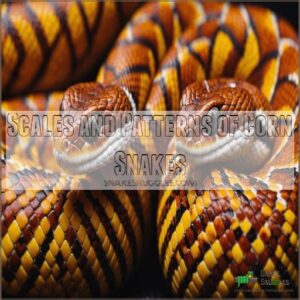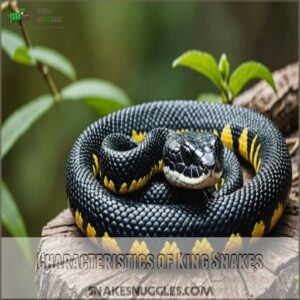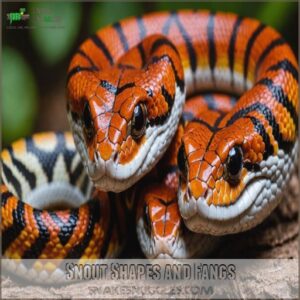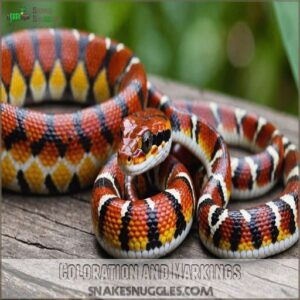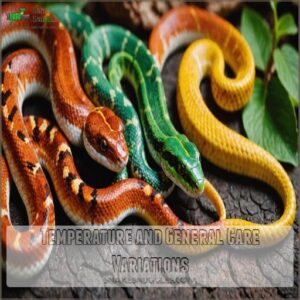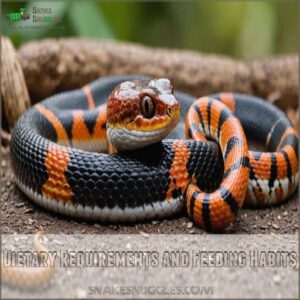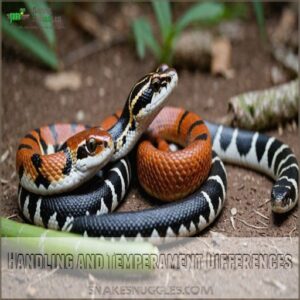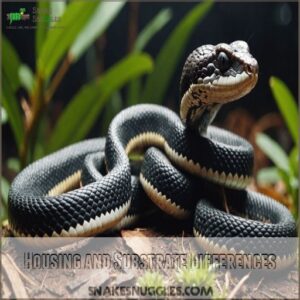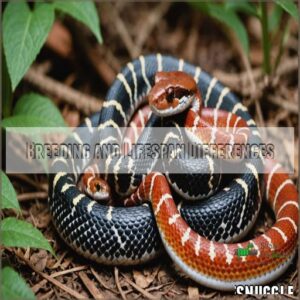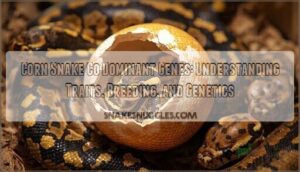This site is supported by our readers. We may earn a commission, at no cost to you, if you purchase through links.
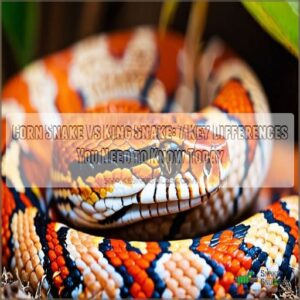
You’ll notice king snakes are generally more active and might be a bit more demanding to handle – they’re the go-getters of the snake world! Corn snakes, on the other hand, are usually more laid-back and budget-friendly, perfect for first-time snake owners.
Both are non-venomous constrictors with similar care needs, though their unique quirks and behaviors can make for vastly different experiences as pets. The real magic lies in understanding their distinct personalities and care requirements.
Table Of Contents
- Key Takeaways
- Key Physical Differences
- Size and Habitat Differences
- Temperature and General Care Variations
- Dietary Requirements and Feeding Habits
- Handling and Temperament Differences
- Housing and Substrate Differences
- Breeding and Lifespan Differences
- Frequently Asked Questions (FAQs)
- What is the difference between a king snake and a corn snake?
- Can a corn snake live with a king snake?
- How do you tell if a snake is a corn snake?
- Are corn snakes violent?
- Are corn snakes or king snakes better climbers?
- Which snake is better for handling around children?
- Do these snakes recognize their owners?
- Can corn snakes and king snakes live together?
- How often do they shed their skin?
- Conclusion
Key Takeaways
- King snakes outsize corn snakes – they’ll grow up to 72 inches and 77 ounces, while corn snakes max out at 60 inches and 32 ounces.
- You’ll find corn snakes are more beginner-friendly due to their docile nature, while king snakes, requiring a secure, medium-sized terrarium setup guide, are more active and may require experienced handling.
- Your setup needs will differ – king snakes need at least a 40-gallon tank, whereas corn snakes are content in 30 gallons, though both require secure enclosures to prevent escapes.
- You can expect different lifespans – providing proper care, including a suitable temperature gradient and basking area, is crucial for a king snake’s longevity. King snakes typically live 15-20 years in captivity, outliving corn snakes by 5-10 years.
Key Physical Differences
You’ll notice distinct physical differences between corn snakes and king snakes at first glance.
From their varied color patterns to their unique body shapes, these serpents showcase nature’s diversity in reptilian design.
Scales and Patterns of Corn Snakes
Your corn snake’s scales are smooth and glossy, creating a sleek appearance.
These scales serve important functions, including protection and moisture retention.
You’ll notice distinct color variations, typically featuring orange or red base hues with black-bordered blotches.
Pattern types can differ based on regional differences, with some snakes displaying more vibrant or muted colors.
Their unique scale texture and patterns make corn snakes a visually striking member of the Lampropeltis genus.
Characteristics of King Snakes
Diversity reigns supreme among king snakes. These serpents boast a kaleidoscope of colors and patterns, from striking black and white bands to vibrant reds and yellows. King snakes, members of the Colubridae family, are non-venomous constrictors with smooth, glossy scales. They’re typically larger than corn snakes, reaching up to 72 inches in length.
- Color variations: Black with white bands, red with black rings, or solid yellow
- Defense mechanisms: Mimicry of venomous coral snakes, hissing, and musking
- Habitat preferences: Adaptable to various environments, from forests to deserts
These royal reptiles are known for their impressive prey-subduing skills and diverse habitats.
Snout Shapes and Fangs
Several key differences in snout shapes and fangs set corn snakes and king snakes apart.
Let’s examine these fascinating features that impact their feeding habits and hunting strategies.
| Feature | Corn Snake | King Snake |
|---|---|---|
| Snout Shape | Rounded, blunt | Slightly pointed |
| Fang Type | Small, rear-facing | Small, rear-facing |
| Venom | Non-venomous | Non-venomous |
| Jaw Flexibility | Moderate | High |
| Constriction Strength | Moderate | Strong |
Both snakes have adapted for efficient prey capture, but king snakes’ pointed snouts and stronger jaws give them an edge in subduing larger prey.
Coloration and Markings
Coral snakes and king snakes have different band patterns, as seen in the distinct red bands warning signs that help identify the venomous coral snake. Typically, corn snakes and king snakes sport distinct color patterns that’ll catch your eye.
Corn snakes often flaunt warm orange or red hues with black markings, while king snakes rock a variety of looks.
Here’s a quick rundown:
- Corn snakes: Reddish-orange base with black-bordered red blotches
- King snakes: Black with white bands, or vibrant red, yellow, or even blue patterns
- Both: Regional variations and unique morphs that’ll make your jaw drop
These striking designs aren’t just for show—they’re nature’s camouflage, helping these slithery pals blend in and stay safe.
Size and Habitat Differences
You can learn more about king snakes and their unique characteristics, such as their ability to consume venomous snakes. You’ll find that corn snakes and king snakes differ greatly in size and preferred habitats.
Corn snakes are generally smaller, reaching 24-72 inches in length, while king snakes can grow larger, ranging from 36-72 inches.
Both species favor forested areas but exhibit distinct burrowing and hiding behaviors.
Length and Weight Variations
In terms of size comparison, king snakes often outstrip their corn snake cousins.
You’ll find king snakes stretching up to 72 inches, while corn snakes top out around 60 inches.
Weight-wise, king snakes can tip the scales at a hefty 77 ounces, dwarfing corn snakes at a modest 32 ounces max.
As for growth rate, both species reach their full size in about 2-3 years, with females typically growing larger than males.
Forest or Wooded Area Preferences
Beyond their size differences, these serpents showcase unique forest preferences that’ll help you understand their natural behaviors.
Your corn snake’s natural camouflage works best in deciduous forests, while kingsnakes adapt to various wooded areas.
Here’s what makes their habitats special:
- Corn snakes thrive in pine forests with scattered logs
- Kingsnakes prefer mixed woodlands with dense undergrowth
- Both species share habitat overlap in southeastern oak groves
Burrowing and Hiding Behaviors
In their natural habitats, these serpentine masters of disguise show fascinating differences in how they make themselves at home.
You’ll notice corn snakes love to burrow deep in loose substrate, creating cozy underground hideaways.
King snakes, though equally secretive, prefer exploring surface-level hiding spots.
Let’s look at how these hiding behaviors shape their perfect habitat setup:
| Behavior | Corn Snake | King Snake |
|---|---|---|
| Burrowing Depth | 6-8 inches deep | 2-3 inches deep |
| Preferred Hideouts | Underground tunnels | Hollow logs, rocks |
| Activity Pattern | Nocturnal explorer | Dawn/dusk adventurer |
Temperature and General Care Variations
You’ll need to maintain different temperature ranges for corn snakes and king snakes, with corn snakes preferring slightly warmer basking spots at 90°F compared to king snakes at 88°F.
While both species need similar humidity levels between 50-60%, you’ll find that their specific care requirements differ when it comes to feeding schedules and enclosure arrangements.
Ideal Temperature Ranges
Temperature control sets the stage for your snake’s comfort and health. While corn snakes thrive in basking spots around 90°F, king snakes prefer slightly cooler temperatures at 88°F. You’ll want to maintain proper temperature gradients in their enclosures to mimic their natural environment. Just like you’d adjust your thermostat at home, these reptiles need different zones for ideal well-being.
- A basking spot lamp provides a warm area for digestion
- Digital thermometers guarantee accurate temperature monitoring
- Heat mats offer consistent bottom heating
- Multiple temperature zones allow natural thermoregulation
- Seasonal temperature adjustments support natural behaviors
Humidity Requirements
While both snakes handle dry conditions well, you’ll need to monitor their humidity levels closely.
Corn snakes thrive at 50-60% humidity, just like their king snake cousins.
You can maintain ideal snake humidity by misting the enclosure twice weekly and providing a large water bowl.
For proper ventilation, make sure your substrate stays slightly damp but never soggy – your scaly friend will thank you!
Lighting and Heating Options
Setting up proper heating for your snake is like creating a cozy home.
Your corn snake needs a basking spot of 90°F, while king snakes prefer it slightly cooler at 88°F.
You’ll want to install ceramic heaters or heat lamps with thermostat control to maintain these temps.
Both species don’t require UVB lighting, but under-tank heaters help create a natural temperature gradient they’ll love.
Dietary Requirements and Feeding Habits
Corn snakes primarily eat rodents, such as mice, rats, and quail, as opposed to the kingsnakes varied prey. You’ll notice some key differences in what corn snakes and king snakes prefer to eat, as well as how often they need their meals.
While both snakes are excellent eaters in captivity, their specific dietary needs and feeding schedules can help you make an informed choice about which species might better suit your lifestyle.
Prey Preferences
How do these two nonvenomous snakes differ in their prey preferences?
You’ll find that corn snakes and king snakes, with the latter being non-venomous constrictors that are immune to rattlesnake venom, have distinct dietary needs that affect their feeding habits.
Like all snakes, they’re carnivores and consume a variety of prey, which influences their hunting strategies.
Here’s what you need to know about their prey preferences:
- Corn snakes typically favor smaller prey like mice and young rats
- King snakes handle larger prey and even consume other snakes
- Both species prefer pre-killed prey for safer feeding practices
Feeding Frequency and Schedule
Now, let’s talk about feeding schedules.
Both corn snakes and king snakes have different meal frequencies, which can affect your pet care routine.
| Snake Type | Feeding Frequency | Prey Size |
|---|---|---|
| Corn Snake | Every 7-14 days | Small |
| King Snake | Every 10-14 days | Larger |
Remember, young snakes need more frequent meals.
As your scaly friend grows, you’ll adjust their feeding schedule.
Keep an eye on their weight and behavior to make sure they’re getting just the right amount of food.
Pre-Killed Vs Live Prey
When it comes to feeding your colubrid constrictor snakes, you’ll need to choose between pre-killed and live prey.
Both corn snakes (Pantherophis guttatus) and king snakes (Lampropeltis getula) can thrive on pre-killed meals, which offer several advantages: finding the right king snake food sources can be important for their diet.
- Reduced risk of injury to your snake from struggling prey
- Better control over nutritional value and food safety
- Easier storage and feeding schedule management for beginner reptile owners
Pre-killed prey is generally recommended for both species, balancing snake health, ethical considerations, and convenience.
Handling and Temperament Differences
In terms of handling, corn snakes and king snakes exhibit distinct temperaments that can greatly impact your experience as a snake owner.
Corn snakes are generally docile and easy to handle, rarely biting even when startled, while king snakes tend to be more active and may display constricting behavior, requiring more careful and experienced handling.
Corn Snakes’ Calm Nature
You’ll find corn snakes are the gentle giants of the snake world.
Their calm temperament makes handling a breeze, even for beginners.
Unlike their more active cousins, corn snakes rarely bite and often freeze when startled.
This docile nature stems from generations of captive breeding.
With regular, gentle interaction, you’ll build trust and create a strong bond.
It’s like having a scaly, low-maintenance friend who’s always up for a cuddle.
King Snakes’ Active and Constricting Behavior
King snakes are the go-getters of the snake world. They’re known for their active nature and impressive constricting skills. When handling these snakes, be prepared for their boldness, as they tend to handle human interaction better than some of their closely related species, like milk snakes that are masters of camouflage. – Frequent movement and exploration – Strong constriction reflexes, even during handling – Defensive behavior like hissing or tail-shaking
Implications for Snake Owners
Choosing between a corn snake and a king snake impacts your handling experience. Corn snakes are typically docile, making them ideal for beginners. King snakes, while more active, may require extra caution during handling.
Consider these differences when setting up your enclosure and planning your care routine:
| Aspect | Corn Snake | King Snake |
|---|---|---|
| Temperament | Calm, rarely bites | More active, may constrict |
| Handling | Easy for beginners | Requires more experience |
| Feeding | Less aggressive eater | More enthusiastic, be cautious |
To make informed decisions about your snake’s setup, check out this helpful resource on king snake care.
Remember, patience and consistent handling are key to building trust with either species.
Housing and Substrate Differences
You’ll need to create distinct homes for your corn snake and king snake, as they’ve different housing needs.
Both snakes require secure enclosures with appropriate substrates, but their size requirements and preferred hiding spots vary, affecting how you’ll set up their habitats.
Enclosure Size and Security
Both snakes need different homes to match their personalities.
A corn snake lives comfortably in a 30-gallon tank, while your king snake will need at least 40 gallons to roam.
But here’s the catch – these escape artists are masters at finding tiny gaps!
Make sure your enclosure has secure latches and proper ventilation.
Think of it like building a cozy, yet secure fortress for your scaly friend.
Substrate Options and Recommendations
You’ll want to line your snake’s home with the right stuff – aspen shavings work great for both corn and king snakes, letting them burrow naturally.
Cypress mulch is another solid choice that retains moisture well.
For hygiene concerns, stick to a 2-3 inch substrate depth and avoid sand or gravel.
DIY options like newspaper can work in a pinch, though natural bedding typically outperforms artificial alternatives.
Hiding Spots and Decorations
Let’s create a natural habitat that feels like home for your scaly friend.
Corn snakes love cozy hideouts made from cork bark or DIY cardboard boxes, while king snakes thrive with multiple hiding spots at different heights.
For safety and enrichment, add climbing branches, fake plants, and a snug cave.
Mix up the aesthetics with rocks and driftwood to make the enclosure both beautiful and functional.
Breeding and Lifespan Differences
You’ll find significant differences in how long corn snakes and king snakes live, with king snakes typically outliving their corn snake cousins by 5-10 years in captivity.
Regarding breeding, you should know that while both species reach maturity at different ages, king snakes take longer to become adults, usually needing up to 5 years compared to corn snakes‘ 2-3 years.
Can King Snakes Breed With Corn Snakes?
Nature’s boundaries don’t always align with our expectations.
While corn snakes and king snakes belong to different genera, they can indeed breed to create corn king hybrids.
Here are three key factors that influence their breeding compatibility:
- Genetic differences affect offspring viability
- Specialized breeding conditions are required
- Success rates remain relatively low
These unique hybrids inherit traits from both parents, though ethical considerations arise.
Their genetic makeup impacts everything from appearance to behavior.
Implications of Hybridization
Crossing corn snakes with king snakes isn’t just about mixing colors – it’s a genetic gamble that can affect health and behavior.
Snake breeding practices, such as prioritizing genetic diversity, are essential in minimizing health risks.
While hybrid snakes might look striking, they often face health risks like weakened immune systems and reproductive issues.
Snake breeders walking this tightrope must weigh ethical considerations against the allure of unique patterns.
The conservation impact remains debated, as future research explores how hybridization shapes genetic diversity in captive populations.
Lifespan and Longevity Expectations
Time’s ticking differently for these serpentine pals.
While corn snakes typically live 10-15 years, king snakes can stick around for 15-20 years in captivity – some even hitting the big 3-0 with excellent care.
Your setup makes all the difference: proper temps, regular meals, and stress-free living can help your scaly friend live its best, longest life.
Want to be a snake’s retirement plan? King snakes might be your golden ticket!
which is easily achieved with proper equipment and products for corn snake care, such as those found at a reptile care store.
Frequently Asked Questions (FAQs)
What is the difference between a king snake and a corn snake?
Slithering serpents show distinct differences: King snakes are typically larger and more aggressive, while corn snakes are gentler pets.
You’ll find king snakes can reach 77 ounces, but corn snakes stay lighter at 32 ounces max.
Can a corn snake live with a king snake?
You shouldn’t house corn snakes and king snakes together.
King snakes are known to eat other snakes, including corn snakes.
For their safety and well-being, keep these reptiles in separate enclosures.
How do you tell if a snake is a corn snake?
Like a sunset painted in scales, corn snakes stand out with their vibrant orange-red coloration and black-bordered patches.
They’ll catch your eye with their slender build, reaching 24-72 inches, and smooth, shiny scales.
Are corn snakes violent?
Corn snakes aren’t violent at all – they’re actually quite docile pets!
They’ll freeze when startled rather than attack, and rarely bite unless they’re really provoked.
Their calm nature makes them perfect for beginner snake owners.
Are corn snakes or king snakes better climbers?
King snakes win the climbing contest hands down!
They’re natural acrobats, often scaling branches in their habitat.
While corn snakes can climb too, they’ll generally stick closer to the ground, preferring a low-key lifestyle.
Which snake is better for handling around children?
While snakes might seem scary, choosing the right one matters.
You’ll find corn snakes are your best bet around kids – they’re calmer, less likely to bite, and their docile nature makes handling safer and more enjoyable.
Do these snakes recognize their owners?
You’ll find these reptiles don’t truly recognize owners like dogs do, but they can become familiar with your scent and handling.
Through consistent interaction, they’ll be less defensive and more comfortable during your encounters.
Can corn snakes and king snakes live together?
Never house these snakes together – king snakes are known to eat other snakes, including corn snakes.
Keep them in separate enclosures to guarantee their safety and well-being.
It’s just not worth the risk.
How often do they shed their skin?
Both corn snakes and king snakes shed their skin regularly, typically every 3 to 8 weeks depending on growth rate.
They’ll become dull and cloudy-eyed before shedding in one complete piece.
It’s nature’s way of letting them grow!
Conclusion
Whether you’re leaning toward a corn snake or a king snake, you can’t go wrong – both make fantastic pets with their own unique charms.
Sure, choosing between them might seem tricky at first, but now you’ve got the scoop on their key differences.
From size and temperament to care needs, understanding the corn snake vs king snake debate helps you make the best choice for your lifestyle.
Remember, whichever you pick, you’re in for an amazing adventure with these fascinating reptiles.
Just be ready for some seriously cool conversations with fellow snake enthusiasts!

